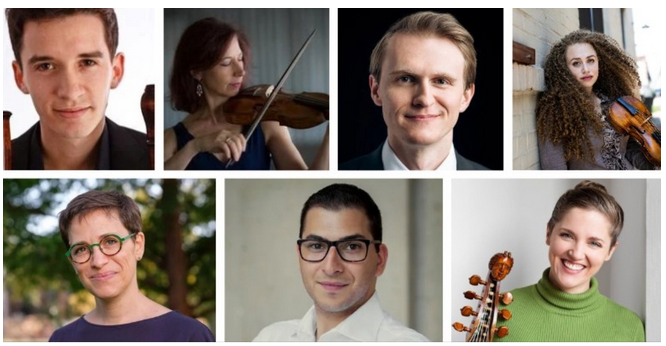by Peter Feher

In adapting these familiar violin concertos to the strengths and tastes of Les Délices — her period-instrument ensemble that continues to push historical performance in unexpected directions — Nagy has achieved something singular.
Rather than be reined in by the 18th century and stuck wondering how Vivaldi’s original scores might have sounded, Les Délices has instead honored the timelessness of these compositions by transforming them for the occasion. The charming result — which ranged well beyond Vivaldi and the violin — was the concluding program of the ensemble’s 2023-24 season.
And few concerts this spring will likely go out in more fitting fashion. The lively strains of that most famous concerto in Vivaldi’s cycle, “Spring,” were reinvigorated in Les Délices’ interpretation, which gave the solo part to guest flutist Joseph Monticello. His dulcet playing was the perfect conclusion to the April 13 performance at Disciples Christian Church, sweetly encapsulating the spirit of the program.
Paradoxical as it may seem, changing a composer’s score can in fact be a matter of history and fidelity. Ever since their publication in 1725, The Four Seasons have been taken up and tinkered with by professional and amateur musicians alike — including the Enlightenment philosopher Jean-Jacques Rousseau, whose solo flute transcription of “Spring” was the basis for Les Délices’ arrangement. Certainly, the trills and bird calls in the first movement, and the lilting bagpipes in the third, have never sounded more convincing.
The clever decision to set “Autumn” as a double concerto for double reeds was all Nagy’s, however. She and guest bassoonist Clay Zeller-Townson playfully evoked the drunken, bumbling atmosphere that follows fall festivities, though there was no disguising the virtuoso control possessed by both soloists, apparent in even the silliest musical moments.
Still, there are some gestures that only string players can pull off, and Nagy made a smart, selfless move in paring back the instrumentation for “Winter.” Violist da gamba cc with the help of violinists Julie Andrijeski and Shelby Yamin, handled the ruminations and ricochets of the first movement. Andrijeski soloed on the long, lyrical lines of the second movement, punctuated here and there by tasteful ornaments, before harpsichordist Mark Edwards whipped up something of a storm in the third.
Listeners could track every shift in the weather thanks to the accompanying poetry (perhaps written by Vivaldi) that was projected on a screen above the stage — even when the performers opted for a different score. Les Délices’ “Summer” preserved the Italian composer’s imagery but swapped in assorted music by his French contemporary Jean-Philippe Rameau, ending with the storm scene from the latter’s 1745 opera Platée.
Two additional pieces brought the program full circle. Everyone got the chance to play an original part in Joseph Bodin de Boismortier’s Concerto for flute, oboe, violin, bassoon, and continuo, Op. 37, No. 6 — the one work on the concert that wasn’t rearranged. And in a nod to continuity, the evening began with the Presto from Giovanni Antonio Guido’s “Spring,” itself the start of another Four Seasons.
Published on ClevelandClassical.com May 2, 2024
Click here for a printable copy of this article



